The Academy of the New Church
1876-1926
The Bryn Athyn Elementary School—Otho Ward Heilman
Religious Instruction in the Bryn Athyn Elementary School—George de Charms
The Library—Reginald William Brown
The Bryn Athyn Elementary School top
The history of the Bryn Athyn Elementary School might easily be said to have had its origin in Bryn Athyn proper, for in the records there appears no reference to an "Elementary School" until the generation of people who founded the Academy Schools had moved to the present site of Bryn Athyn to escape the city environment. This, however, would be to quibble over a technicality, since child education, as represented by the Bryn Athyn Elementary School, did not begin as a movement apart from that which brought into being the organization now known as the Academy of the New Church.
If we turn to the records of the "Boys' School" which operated in the basement of the well known Cherry Street building in Philadelphia, we find the elementary school department represented by Class I, while the students of more advanced age were enrolled in Class II. On September 7, in the year 1881, the Boys' School opened with an enrollment for Class I as follows: Rudolph and Louis Tafel, ages six and eight; Willie and Harvey Farrington, ages seven and nine; Gideon and Emanuel Boericke, ages seven and eight. The subjects listed for instruction for Class I were: Religion, Geography, Arithmetic, Reading, Anatomy and Natural History. On February 9, 1884, at the home of Mrs. Sarah de Charms Hibbard, a school for girls was opened with two pupils, Helen Farrington and Edith Hibbard ages seven and nine; and before the year was over there were five pupils with the ages ranging as high as twelve. Miss Alice E. Grant came to Philadelphia especially to teach this group. The work here was mainly Kindergarten and primary. The history of the other departments of the schools may contain references to changes of location, enrollment, supervision and management, while these schools were in the city of Philadelphia, but it is very clear that the beginning of the Elementary School as we have it today is inseparable from the two Cherry Street schools of the early eighties. For example, both Miss Grant and the Rev. Homer Synnestvedt were connected with the elementary work in the city schools and remained with this work until it was well established in Bryn Athyn.
In 1895, after a number of families had moved to the section then known as Huntingdon Valley, sixteen pupils were provided for in the "Old Club House," now remodelled and called the "Inn Annex." In the roll book, this school is listed as the "Huntingdon Valley School." A school was continued in the city, however, for those families who had not moved out to the country; and Mr. Synnestvedt, then recognized head of the Elementary School, made a daily trip by bicycle, teaching in both the city and country schools. In 1896, there were twenty-seven pupils enrolled in the "Huntingdon Valley New Church School,"; and in 1897 there were thirty-three. In 1898, it was necessary to build the "Brown Study" to accommodate the growing school.
In 1897, the year in which Bishop Benade withdrew as Chancellor of the Academy and Bishop W. F. Pendleton became the General Superintendent, the elementary department was taken over by the local church society, and for this reason it became known as the "Local School" in contra-distinction to the secondary department then known as "the College." In 1903, when the Academy schools moved to Benade Hall, the local school was easily provided for in a portion of Benade Hall, until the building of De Charms Hall in 1909, where special provision was made for the eight grades and the kindergarten. The "Intermediate Department" was given up at this time; and one year was added to the elementary school, making eight grades with two years of kindergarten as at present.
The present enrollment of one hundred and twenty-seven (1925-26), represents a normal growth from the community. This growth is distributed fairly evenly over a period of thirty years, and, probably owing to the baptismal requirement which was formally put into effect in the year 1894, there have been few children in the school who were not of New Church parentage.
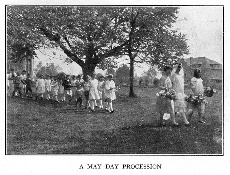
May Day.
Click on image for a larger version.
Since 1897, this elementary school has been the Church school of the local New Church society, which school at present is the largest in the General Church. From the beginning, it has enjoyed many advantages peculiar to the situation in which it has developed. The members of this community have been a people of one purpose. The central idea which all have shared in common has been that of permanently establishing the New Church. The educational system in itself has been secondary to this, but has been recognized as the primary factor in the upbuilding of the church, especially with the individual. As Bryn Athyn, from the beginning, has been a center of learning, a "college town," many of the parents have been engaged in the various uses of the schools, so that the home environment of the children has been an intellectual one. Family worship has been a custom from the beginning. In the school, the situation has likewise been unusual. The teaching of spiritual truth, and a life according to the principles of the Word-the source of spiritual truth-have at all times been regarded as of major importance. The doctrine of use has given life and purpose to the subjects on the curriculum.
The teachers of the elementary school have all been educated in the schools of the Church and therefore in the Doctrines. For the most part they have taken post-graduate work in universities and schools of education. In addition to the regular teaching force, the children have had contact with members of the faculties of the higher schools in special subjects.
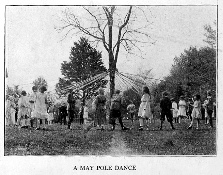
May Pole.
Click on image for a larger version.
At present the instruction in religion is under the direction of the Rev. George de Charms, assistant-pastor of the Bryn Athyn society, who is also the regular instructor in religion in the seventh and eighth grades. In this work Mr. de Charms is assisted, from time to time, by several professors from the theological department. Professor Alfred Acton, Dean of the Theological School, is in charge of the subject of Hebrew, and has, for a number of years, taught Hebrew in the seventh and eighth grades.
In addition to the "common branches," the subjects of Religion, Hebrew, Manual Training, Sewing and Dancing are taught. A Literary Club has been formed for the pupils of the seventh and, eighth grades. Assemblies are held and plays are given periodically for the purpose of providing entertainment for the pupils as well as for their educational value.
During these years of elementary training the school aims to prepare the pupils for entrance into the Boys' Academy and the Girls' Seminary at Bryn Athyn, as well as to develop the affections for good and truth, which are to serve in later life. For this reason both subject matter and methods of instruction are chosen with a recognition of the special interest and ability peculiar to the ages of the pupils.
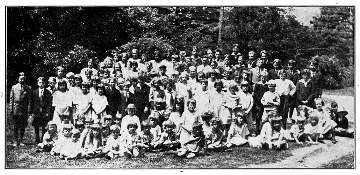
A Typical Group of Elementary School Pupils.
Click on image for a larger version.
The Bryn Athyn Elementary School; although mainly supported by the Bryn Athyn society, is generally considered one of the departments of the Academy Schools. The principal of the school is supported by the Academy, and is a member of the President's Council; and the teachers are all members of the General Faculty of the Academy.
OTHO WARD HEILMAN,
Principal of the Bryn Athyn Elementary School.
Religious Instruction in the Bryn Athyn
Elementary School top
The primary aim of the Bryn Athyn Elementary School is to lay a foundation on which may be built an interior understanding and spiritual appreciation of the Writings of the New Church. For this reason, religion is the pivotal center about which instruction in all the subjects on the curriculum revolves. The course is planned to give a thorough foundation in the Letter of the Word, wherein Divine Truth is given in the form of historic narratives, stories, and parables accommodated to the minds of the children (A. C. 6333, 3982, 10441; A. E. 384.) The Old Testament, as to its historic portion, from Genesis to the end of the Second Book of Kings, may be said to be divinely "graded." Beginning with the simplest kind of a pastoral, wherein the characters are few, and their human relations of the simplest, the story gradually increases in complexity until it becomes a highly involved narration of national life, with many characters and a multiplicity of human motives. Experience of many years has led to such a division of Jewish national life that its steadily growing difficulties may keep pace with the advancing states and abilities of the children as they pass from grade to grade. In the kindergarten and the first grade the more striking stories of the Word are taught as separate word-pictures without any attempt to preserve the chronological sequence. Systematic and connected instruction begins in the second grade; and a year is devoted to the study of the Book of Genesis. In the third grade the children learn the stories of Exodus, and the historic incidents connected with the later books of Moses. The fourth grade studies Joshua and judges, the fifth, the two books of Samuel, and the sixth, the two books of Kings. A course is then given in the seventh and eighth grades in the New Testament Story of the Lord's life.
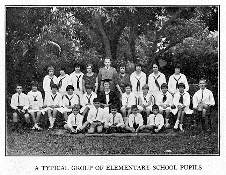
A Typical Group of Elementary School Pupils.
Click on image for a larger version.
Careful attention has been given to the steps which mark the mental development of the children from year to year, and the endeavor to accommodate the teaching as fully as possible to their needs has thrown new light, from the Word itself, upon the important educational study of child psychology. In the inmost sense, the Old Testament, as we are taught in the Heavenly Doctrine, recounts the story of the Lord's life on earth, and because this was a Divine Type of all human development it recounts the life-story of every man. It is not surprising, therefore, that there is to be found in it a key to unlock the mysteries of mental growth. Having established, on the basis of experiment, those portions of the Word best suited to each grade, a search has been made for that leading characteristic in the narrative which would seem to account for its accommodation to the child of a particular age. The result has been the discovery of a certain mode by which the Lord reveals Himself to that age, a certain quality that makes His Word seem real, living, vital to a child at that particular point of development. This quality is then made the basis of a universal appeal to the child. To illustrate: The Genesis story presents the Lord as the Creator, first the Creator of the World, and of mankind, and then the Creator of the Jewish Nation. The story of Moses, on the other hand, presents the Lord as the Redeemer, the Deliverer, and the Law-giver. Joshua and judges give a picture of the Lord as a Divine Hero, raising up a succession of national heroes to establish His people in the land of promise. Samuel, describing the inauguration of the Kingdom, gives a picture of the Lord as the Divine Ruler, guiding the destinies of men and nations. While the Kings, relating the story of the decline and fall, describe the Lord as present among the evil, restraining, mitigating, withholding from greater evil-a picture powerfully drawn in the pleading of the Prophets, their warnings and their promises. Children come successively to realize these various attributes of the Divine, beginning with the simple idea of the Lord as a merciful Heavenly Father, Who made all things perfect, and from Whom is every good, and progressing gradually into a conception of His operation in the complex affairs of human life, in which good and evil are ever mingled, and yet in which the Lord is always present to redeem and save. In the New Testament, all these attributes of Divinity are centered and concentrated in the person of the Lord Jesus Christ-are discovered and illustrated in the story of His life, that in Him may be seen "all the fullness of the Godhead bodily."
Because this unfolding revelation coincides with the spiritual needs of the growing child, it gives a center from which to teach, not only religion, but all secular subjects as well. Thus in the second grade, that the Lord creates all the forms of the universe, and adapts them, from Infinite Wisdom to the needs of man, it is the central thought in the teaching of Nature, History, Geography, Language. In the third grade, the universality of Law, of Order, and the need for obedience, characterizes the teaching of these same subjects. In the fourth grade, the child comes into a state of hero-worship, and through a study of human heroes, a chord sympathetic to the basic interest of the child is touched in every subject taught.
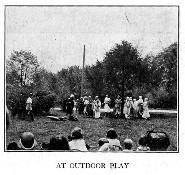
An Outdoor Play.
Click on image for a larger version.
With this as the background in the teacher's mind, there is sought and found in each particular subject, some universal theme which answers to this basic interest, and this is made the point from which all instruction is given. In Nature, for instance, the beginnings of life are first studied, wherein the creative work of the Lord is seen. In the third grade, the laws governing life are studied, as that each animal or plant requires its appointed food, its appropriate climate; that each knows the law of its own life and is wise from the Lord in all matters of self preservation and the perpetuation of its kind. In the fourth grade, the duty of man to care for things of beauty and of use, to guard and protect them, to exercise his human power toward them in emulation of the Lord's own love and mercy toward him. In the fifth grade, there is illustrated how the Lord, as the King and Ruler of the universe, adapts all things wisely to the needs of man. Wood for houses, plants for food and clothing, stones for building and for ornament, these and many other things are studied as evidences of the over-ruling Providence of God. The use of evil forms, of poisons for medicine, of adversity and hardship as elements in the building of character, and other illustrations of how the Lord is present even in the midst of evil bending all things to the fulfilment of His Divine Will is the theme of the sixth grade course. In the seventh grade, where, the Lord is made the center of instruction in the nature work, that in a general survey of its functions there may be a basis for understanding the perfection of that Human in which the Lord revealed Himself.
This general method of correlation is followed throughout the grades and in all the subjects, that, even while the children are learning those facts and processes of nature which are essential to their life in the world, they may, at the same time, receive a basis for spiritual thought-the bread of heaven, to nourish their souls. Their minds are being trained to recognize the Divine end and purpose in all things, and to understand the laws that make for a truly religious life.
We can do no more here than indicate the general foundation of our work. For a more complete description of how it is carried out, the reader is referred to the Curriculum now in process of publication, which contains a summary of all the courses given throughout the grades.
That the children may have, not only an intellectual groundwork of religious training, but also a development of the affectional side with reference to their faith, opening exercises are held every morning, and each class in religion is marked by the opening of the Word and the recitation of a verse from the Scripture. In addition, Children's services are held on Sunday, for which the children make preparation during the week, learning hymns and chants as part of their musical training, and also selections in Hebrew for recitation. The addresses given in the Children's service are simple sermonettes, in which an effort is made to explain in the eight grades, the Prophets, Psalms, Revelations, and those portions of the Scripture not taught in the class-room work. Use is made of the Memorable Relations, and the descriptive portions of the Writings which give a living idea of the other world, and of the human conditions which obtain in the life to come. There is no teaching of Doctrine as such, nor any systematic presentation of abstract concepts found in the Writings. Correspondences are given only incidentally, and to the degree that they can be made real to the children. These things belong to the later state. But the basis for appreciating them, and a mental preparation to enter into an interior understanding of them as they are presented in the higher departments, is the end in view. It is hoped that out of this ground will grow a deep love and an ever more perfect realization, of that high spiritual philosophy of life which is the priceless gift to the race of the Lord in His Second Coming.
GEORGE DE CHARMS,
Assistant Pastor of the Bryn Athyn Society.
The Library top
The beginnings of the Library reach back to the days of the founding of the Academy itself. At a meeting on June 3, 1877, where the Council of the Academy agreed to apply for a charter, it also set aside two hundred dollars for the purchase of books.
Today a library of forty thousand volumes stands as a memorial to the foresight of the founders of the Academy. Men of vision, they began to gather the heritage of the past for the service of the New Church; they resolved in their charter to establish a library as one of the educational foundations of the university which they envisaged.
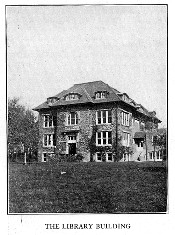
The Library.
Click on image for a larger version.
A library containing everything—every scrap indeed—that Swedenborg wrote and published, everything relating to his life and philosophy and to the history and teachings of the New Church. Such a library, first and foremost, the founders contemplated. Such a library virtually now exists, a treasure-house for the New Church historian, scientist, philosopher and theologian.
As. the priceless collection of Swedenborgiana drew nearer and nearer to completion the library expanded more and more rapidly in other directions. With unusual care in selection on the part of the members of the faculty and of successive librarians, the best in all departments of the arts and sciences is now well represented.
EDUCATIONAL USES OF THE LIBRARY
The Library of the Academy is above all a university and college library. Its primary concern is to provide teachers and advanced students with the tools needed in their researches, and make it possible for them to keep in touch with the ever-moving currents of thought and accomplishment, both within and without the New Church. At the same time the Library cooperates with all phases of the educational work of the schools from the kindergarten onward. This involves supplying suitable books for all ages, and collaboration with teachers for reference and collateral study in all courses. It requires a staff of trained school librarians, capable as educators of guiding and building up interests in worth-while reading.
One would have to search far to find elementary and secondary schools so well equipped for constructive library work. . This is one of the great assets in the Academy's educational work, and is a source of envy to educators visiting our schools.
Students gain much in the training they get in the use of such a library. Individual training is constantly given them, and introductory classes for new groups pave the way to using the library facilities to the best advantage.
Scholarship students assisting in the Library are given more complete training in library economy and technique, with the interesting result that they frequently go into library work after leaving school. Regular library courses are provided whenever possible for those interested in taking up library work as a vocation, and with a view to keeping up an effiicient corps of library assistants.
THE LIBRARY BUILDING
The growth of the Library and of its educational uses was greatly accelerated through the generosity of the late john Pitcairn, who erected -a commodious and fittingly equipped three-storied fire-proof library building. This was completed in 1910, and into it were moved the Academy's precious collections comprising at that time a little over thirteen thousand volumes, which at some risk had crowded the capacity of what are now the faculty room and book room in Benade Hall.
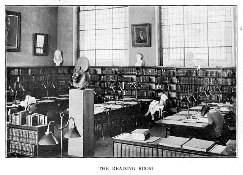
The Reading Room.
Click on image for a larger version.
A spacious REFERENCE AND READING Room occupies the central portion of the main floor. Here the library activities mainly focus. Softened light from high windows, impressive dark oak furniture, walls lined with a choice selection of books and current magazines, all invite to quiet reading and studious reflection. Encyclopedias, dictionaries and atlases are conveniently arranged on low shelves in the center, and an extensive card catalog near the reference desk. One hundred students may be seated at the large oaken study tables.
A wide arch back of the reference desk furnishes easy access to steel stacks sufficient to shelve eighty-five thousand volumes; and additional space above these provides for sufficient expansion to take care of a total of one hundred thousand volumes; barely provision for another generation at the rate the Library has grown in the last fifteen years.
The Theological School occupies a suite of rooms on the second floor of the western end of the library building. One of these rooms is set apart as a Theological Reference and Reading Room, and contains upwards of a thousand volumes.
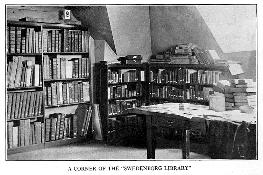
A Corner or the Library.
Click on image for a larger version.
The College uses most of the rooms on the ground floor as office and classrooms.
The CHILDREN'S READING Room on the main floor contains the juvenile collection of 2,200 volumes, with a separate card catalogue. It is a bright, cheerful corner room on the southwest. All the books in it are accessible to the children.
A LANTERN Room on the ground floor with a very simple and efficient projection lantern is kept in readiness for the use of classes; the Library having a collection of several thousand slides, supplemented in turn by collections made by teachers in their respective departments.
Another room on the ground floor is equipped as a LIBRARY WORKSHOP for repairing, making, pasting and the like. This room also contains a photostat machine and other reproducing and multiplying apparatus for the use of the various departments of the schools.
ORIGINAL EDITION ROOM
In a room set apart for the purpose on the main floor, glass-doored cases protect the Academy's very complete and valuable collection of the original editions of Swedenborg's works, and of photolithographed, phototyped, and photostated editions of his manuscripts. Many of the originals contain autographs of early and prominent New Churchmen. But the most precious volume of all is Swedenborg's own copy of Vera Christiana Religio, in which is inscribed in his own handwriting the list of presents which he received in the spiritual world.
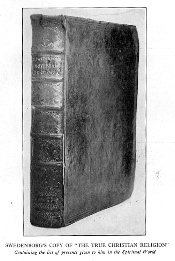
Swedenborg's Copy of "The True Christian Religion".
Click on image for a larger version.
In this Original Edition Room are also shelved in chronological order, in special binders, the Academy's extensive collection of documents, and of copies and translations of documents relating to the life of Swedenborg. It is planned to place there also all contemporary works of Swedenborg's time having direct or indirect bearing on his life and work.
This room will be a veritable unabridged Life of Swedenborg, a much sought retreat for his future biographers.
THE "STAR COLLECTION"
One copy of every edition of Swedenborg's works has been separately shelved as a bibliographical reference collection, and is not allowed to go into general circulation. This unique collection numbers 2,250 volumes, many of which contain several different works. The volumes bear special labels and are arranged according to the chronological classification proposed by Emil F. Stroh during his librarianship. The whereabouts of items published in other volumes, and of autographs and, missing editions is recorded on suitable wooden dummies which were painstakingy prepared by the Rev. Ernst Pfeiffer. The collection is over ninety per cent complete and is being added to constantly.
With this collection are also shelved noteworthy autographed copies, and such valuable volumes of reference as those used by the late John Faulkner Potts, in the preparation of the Swedenborg Concordance-a memorial gift to the Academy from his family.
In addition to this "Star Collection" the library has over three thousand volumes of Swedenborg for general circulation. Many of these volumes are distributed in sets throughout the various departments and classrooms of the schools and are in constant demand.
THE "SWEDENBORG LIBRARY"
What a thrill to the student of Swedenborg to be able to visit Swedenborg's library, to see the books he was surrounded and worked with, to actually handle and study them, check up the references he made to them, and trace their influence upon his thought. Nowhere throughout the wide world is such a thing so completely realizable as in "Room 17" of the library building. For here are gathered not only copies of the volumes that are known to have been in Swedenborg's own library, but also the numerous works referred to and quoted by him throughout his scientific and` philosophical career, as well as other contemporary works, encyclopedias, dictionaries, and so forth, which may be of assistance to the student in understanding the conceptions and terminology of Swedenborg's day.
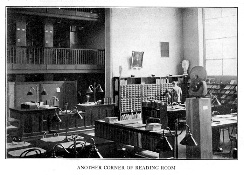
The Reading Room.
Click on image for a larger version.
The shelves in "Room 17" are sufficient to hold only 2,005 of the more important volumes in this collection, many others are shelved in the general library.
Future generations even more than our own will appreciate the possibilities that this "Swedenborg Library" presents for New Church research, and will be grateful to Professor Alfred Acton for the untiring efforts he has made to build it up.
THE ARCHIVES
Since its early days the Academy has collected and preserved letters and documents of biographical and historical interest relating to the men and organizations of the New Church.
When the library building was completed in 1910, an Archives Room was provided and adequately equipped with filing cases in which these archives are now classified, numbered, and indexed for purposes of historical reference and study.
THE MUSEUM
Early in the history of the Academy of the New Church Chancellor Wm. Henry Benade saw that the New Church would have to make a first hand study of the records and remains of ancient civilizations in the light of the new revelation. During the second year of the Academy's chartered existence we find him making a prolonged search through Italy, Greece and Egypt for material that would throw light upon the influence of the Ancient Church. He was collecting representative specimens of art and archaeology "for future use" as he wrote from Rome on November 12, 1878. He was laying the foundations of the Academy's very, remarkable Museum, which furnishes so splendid an opportunity for teachers to' introduce their students into a living appreciation of art, history and geography,' especially of ancient peoples.
The sympathetic interest and cooperation of John Pitcairn made it possible for Chancellor Benade to procure the Lanzone Egyptian Collection, consisting of 1,300 specimens collected in the early days of Egyptian exploration, to illustrate the mythology and symbolic art of Ancient Egypt. Students of the late Professor C. Th. Odhner cherish memories of the profound interest awakened through the study of this and the smaller collections of Roman, Grecian and Etruscan pottery made at the same time.
In recent years Mr. Raymond Pitcairn has deposited in the Museum a notable group of Mediaeval and Gothic sculptures. The Rev. Theodore Pitcairn has added choice collections of Egyptian, Assyrian and Chinese sculptures, and of Chinese and Japanese paintings. Subtle and far-reaching is the educational inspiration and influence of such works of art, the human and religious story they embody being so vast. A single alabaster slab from the "Hall of Divintites" in Assur-nazir-pal's palace at Calah near Nivneh proved to one class a veritable doorway into the realms of Assyrian and Babylonian history. Such doorways in abundance the Museum now contains.
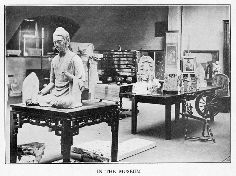
The Reading Room.
Click on image for a larger version.
Collections of coins; of relics of the American Indians; of Roman remains from Colchester, England; others from Alaska, Basutoland, and elsewhere; casts of historic monuments like the Rosetta Stone and the Black Obelisk in the British Museum; a group of original and representative Babylonian tablets; besides other significant specimens from many parts of the world, have been added from time to time.
The Museum has long since outgrown the capacity of the large hall above the Reading Room. Many items are displayed in other rooms; and the Geological, Mineralogical, and Biological collections used by the Science Department are housed on the third floor of Benade Hall.
The Department of Philately is in charge of Professor Win. B. Caldwell. The Academy's collection of postage and revenue stamps of all countries, begun a few years ago, has been steadily growing, due to the interest of patrons and friends who have contributed collections and rarer issues.
USES TO THE PUBLIC
The library and museum are open to the public, and are used extensively by parents and other members of the community. A children's story hour is arranged for the summer months. In recognition of these facts the Borough of Bryn Athyn makes a small annual appropriation, which is specifically applied toward keeping the library open during the summer vacation.
By Reginald William Brown?-(penciled in library copy)